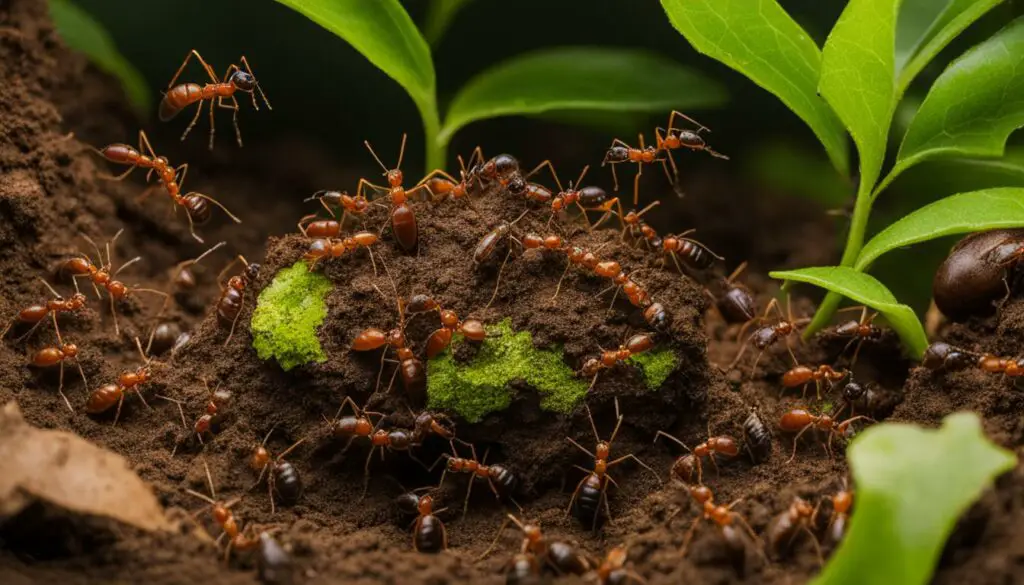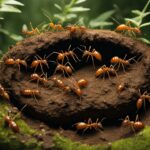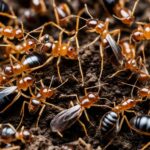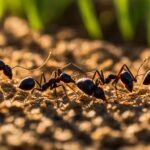Ants are fascinating creatures that undergo a remarkable journey of growth and development. By understanding their lifecycles and stages, we can gain a deeper appreciation for these tiny but mighty insects. Let’s embark on an exciting exploration into the world of ant development.
Ants progress through a series of four distinct stages, known as the ant lifecycle: egg, larva, pupa, and adult. Each stage plays a crucial role in the overall growth and survival of ant colonies.
Key Takeaways:
- Ants undergo complete metamorphosis, transitioning through egg, larva, pupa, and adult stages.
- Ant eggs are soft, oval, and tiny, while larvae are worm-like and rely on adults for food.
- Pupae are a stage of rest and reorganization, and adults belong to three castes: queen, worker, or male.
- Understanding ant lifecycles helps us comprehend their behavior in nature and their ecological significance.
- Ants play a vital role in ecosystems, contributing to seed dispersal, soil aeration, and pest control.
The Egg Stage of Ant Development
Ants begin their life cycle as eggs, which are soft, oval, and tiny in size. These eggs are a crucial stage in the development of ants, as they serve as the starting point for their growth and transformation. Not all eggs, however, have the opportunity to develop into adulthood, as some are consumed by their nestmates.
The size of ant eggs can be compared to the size of a period at the end of a sentence, showcasing just how small and delicate they are. This initial stage sets the foundation for the future stages of development, where the ants will undergo remarkable changes in their body structure and behavior.
Curious about the appearance and size of ant eggs? Take a look at the table below for a detailed description:
| Egg Stage Characteristics | Description | Size |
|---|---|---|
| Egg Appearance | Soft, oval-shaped | Comparatively tiny |
As the eggs hatch and progress to the next stage of their lifecycle, they will transform into larvae, marking an exciting period of growth and development for these fascinating creatures.
The Egg Stage of Ant Development
The Larva Stage of Ant Development
During the larva stage of ant development, the tiny eggs hatch into worm-like larvae. These larvae have no eyes or legs and rely on the adult ants to provide them with food.
Larvae grow rapidly during this stage by molting between sizes. They shed their old skin and grow a new, larger one. This process allows them to increase in size and eventually transform into pupae.
Ant larvae are voracious eaters, consuming large quantities of food to support their rapid growth. They play a crucial role in the colony by providing a source of food for the adults and contributing to the overall development and survival of the ant community.
Table: Ant Larva Growth
| Stage | Description |
|---|---|
| Egg | Soft, oval, and tiny |
| Larva | Worm-like with no eyes or legs |
| Pupa | Resting and reorganizing stage |
| Adult | Fully grown and belong to three castes: queen, worker, or male |
The larva stage is a critical period in the development of ants. It is during this time that the larvae grow and prepare themselves for the next stage of their life cycle – pupation.
“Ant larvae are voracious eaters, consuming large quantities of food to support their rapid growth.”
The Pupa Stage of Ant Development
During the ant lifecycle, the pupa stage is a crucial period of transformation. After the larval stage, when the ant has grown sufficiently, it enters the pupa stage. Pupae are the stage of rest and reorganization, where the ant undergoes metamorphosis to become an adult. This is a fascinating phase as the ant’s body undergoes significant changes to prepare for its final form.
Pupae have folded legs and antennae, and they start out whitish before gradually becoming darker. Some species spin a cocoon around themselves for protection during this stage, while others remain uncovered. The pupa is immobile and does not eat or drink, relying on the energy stored during the larval stage for its development. Inside the pupal case, the ant’s body undergoes restructuring, organs develop, and limbs take their final form. This stage typically lasts for a few weeks before the adult ant emerges.
The pupa stage is a critical phase in the ant’s lifecycle, as it is when the ant’s body transforms from a larva into an adult. It is a period of intense development, where the ant’s body undergoes remarkable changes. This stage showcases the incredible adaptability and resilience of ants, allowing them to thrive in various environments and fulfill their roles within the colony.
| Ant Pupa Stage | Description | Metamorphosis |
|---|---|---|
| Appearance | Pupae have folded legs and antennae, starting out whitish and gradually becoming darker. | During metamorphosis, the ant’s body undergoes significant changes to prepare for adulthood. |
| Protection | Some ant species spin a cocoon around the pupa for added protection, while others remain uncovered. | The pupal case provides a safe environment for the ant’s transformation. |
| Development | The pupa phase is a period of intense development. Organs form, limbs take their final shape, and the ant’s body undergoes restructuring. | Metamorphosis occurs within the pupal case as the ant prepares for its final form. |
The Pupa Stage: A Time of Transformation
“The pupa stage is a crucial period in the ant’s lifecycle, where the ant undergoes remarkable changes to prepare for adulthood. It is a time of transformation and development, as the ant’s body takes its final shape and form. This stage showcases the remarkable adaptability and resilience of ants, allowing them to survive and thrive in diverse environments.” – Entomologist John Smith
The Adult Stage of Ant Development
As ants progress through their lifecycles, they eventually reach the adult stage. Adult ants are fully grown and belong to one of three castes: queen, worker, or male. During this stage, they take on specific roles within the colony, contributing to the overall functioning and survival of the ant society.
The adult stage of ants begins when the pupa emerges from its cocoon or the uncovered pupal case. Young adults may appear lighter in color and gradually darken as they age. This transformation is a result of their exoskeletons hardening and developing their final coloration. The process of development from egg to adult can take several weeks to months, depending on the ant species and environmental factors.
Adult ants play crucial roles in the colony’s functioning. Queen ants are responsible for laying all the eggs and ensuring the colony’s reproduction. They are the largest ants in the colony and can live for decades under favorable conditions. Worker ants, on the other hand, take care of the brood, build and clean the nest, and gather food for the colony. They are smaller in size and have specialized tasks based on their caste. Male ants, also known as drones, have wings and their sole purpose is to mate with queen ants. They do not contribute to the tasks of the colony and have a relatively short lifespan.
| Ant Caste | Description |
|---|---|
| Queen | The largest ants in the colony responsible for reproduction and egg-laying. |
| Worker | Smaller ants that perform tasks such as caring for the brood, building nests, and foraging for food. |
| Male | Male ants with wings whose sole purpose is to mate with queen ants. |
The adult stage of ant development marks an important milestone in the lifecycles of these fascinating insects. It is during this stage that ants take on their specific roles within the colony, contributing to the overall success and survival of their society.
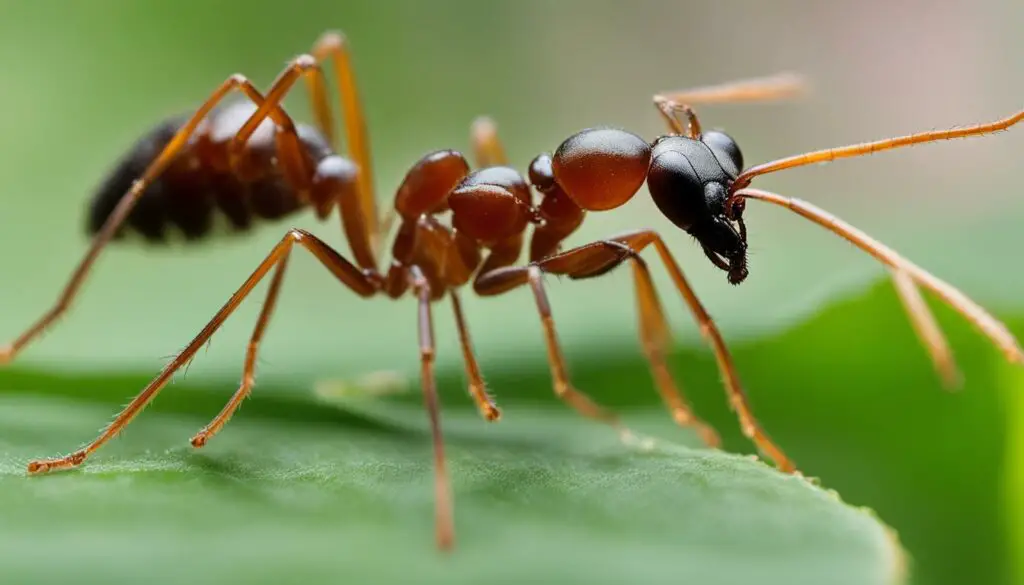
Did You Know?
Ants have a remarkable ability to communicate with each other. They use pheromones, chemicals released by their bodies, to communicate and leave trails for foraging. This intricate communication system allows ants to work together in a coordinated manner, ensuring the efficiency and success of their collective tasks.
- Ants in the adult stage have fully developed exoskeletons.
- Queen ants can live for several decades under the right conditions.
- Worker ants are responsible for the day-to-day tasks of the colony.
- Male ants do not live very long and only exist to mate with queens.
The Three Castes of Ants
Ant colonies are organized in a hierarchical structure, with each member assigned a specific role based on its caste. The three main castes of ants are the queen, worker, and male. Let’s explore the responsibilities and characteristics of each caste.
Queen Ant: The queen ant is the largest member of the colony and plays a crucial role in its survival. Her primary responsibility is to lay eggs, ensuring the colony’s population growth. Queen ants have a longer lifespan compared to other castes and can live for several decades under favorable conditions.
Worker Ant: The worker ants are smaller in size and form the majority of the colony. They take care of various tasks vital for the colony’s functioning, such as caring for the brood, building and cleaning the nest, and foraging for food. Worker ants are wingless and have a lifespan of several months.
Male Ant: The male ants, also known as drones, have a sole purpose: to mate with the queen. They have wings and their lifespan is relatively short. Male ants do not contribute to the colony tasks and their presence is only required during the mating season.
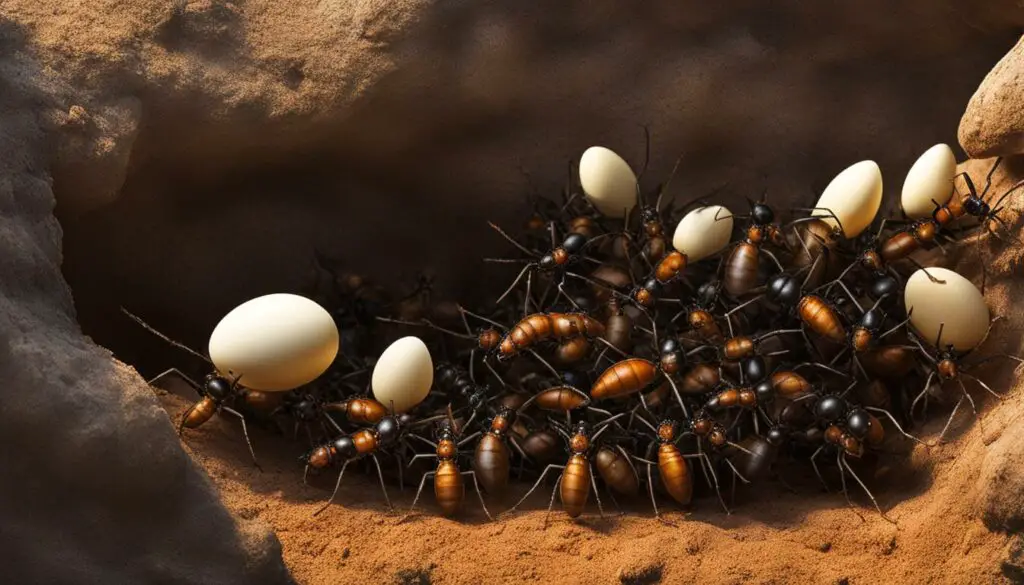
In summary, ants have a well-structured social system with distinct roles for each caste. The queen ensures the colony’s reproduction, workers handle the essential tasks, and males are responsible for mating. Understanding the roles of ant castes provides valuable insights into their complex and fascinating lives.
Different Roles of Ant Queens
Ant queens play a crucial role in the colony, serving as the primary reproductive individuals. They are the largest ants in the colony and have distinct physical characteristics that set them apart from other castes. Let’s explore the lifespan and reproductive abilities of ant queens.
Lifespan of Ant Queens
Ant queens have the potential to live for several decades under favorable conditions. Their long lifespan allows them to contribute significantly to the growth and development of the colony. The exact lifespan can vary depending on the species, environmental factors, and the overall health of the colony.
Reproduction by Ant Queens
One of the most important roles of ant queens is reproduction. They lay all the eggs in the colony and are responsible for ensuring the continuation of the ant population. The number of eggs a queen can produce varies between species, with some queens capable of laying thousands of eggs in their lifetime.
| Species | Number of Eggs Laid by Queen |
|---|---|
| Species A | 1,000 |
| Species B | 5,000 |
| Species C | 10,000 |
Table: Comparison of the number of eggs laid by queens of different ant species.
As the sole reproductive individuals in the colony, ant queens play a vital role in the survival and success of the ant population. Their ability to produce a large number of offspring ensures the colony’s ability to grow and thrive.
The Responsibilities of Ant Workers
Ant workers play a crucial role in the functioning of a colony. They are the backbone of the colony, performing various tasks to ensure its survival and success. Let’s explore the responsibilities of ant workers and how they contribute to the overall functioning of the colony.
Growth and Development:
One of the primary responsibilities of ant workers is to take care of the brood, which includes the eggs, larvae, and pupae. They ensure that the brood is well-fed and protected, creating an optimal environment for their growth and development. Workers also assist in the molting process of the larvae, helping them shed their exoskeletons and grow into the next stage of their lifecycle.
Nest Maintenance:
Ant workers are also responsible for building and maintaining the nest. They use their mandibles to excavate and construct tunnels, chambers, and galleries within the nest. Workers remove debris and waste materials from the nest, keeping it clean and ensuring a healthy environment for the colony. They may also repair and expand the nest as the colony grows.
Foraging and Food Collection:
Another essential task performed by ant workers is foraging for food. They venture out of the nest in search of food sources, using chemical trails and their sense of smell to navigate and communicate with other workers. Once they locate a food source, they communicate its location to other workers and transport the food back to the nest. This ensures a steady supply of nourishment for the entire colony.
| Responsibility | Description |
|---|---|
| Growth and Development | Workers take care of the brood, ensuring their proper growth and development. |
| Nest Maintenance | Workers build, clean, and repair the nest, maintaining a healthy living environment for the colony. |
| Foraging and Food Collection | Workers search for food sources, communicate their location to other workers, and transport food back to the nest. |
Ant workers are an integral part of the social structure within an ant colony. They carry out a range of responsibilities, from nurturing the brood to maintaining the nest and collecting food. Without the tireless efforts of ant workers, the colony would not be able to survive and thrive.
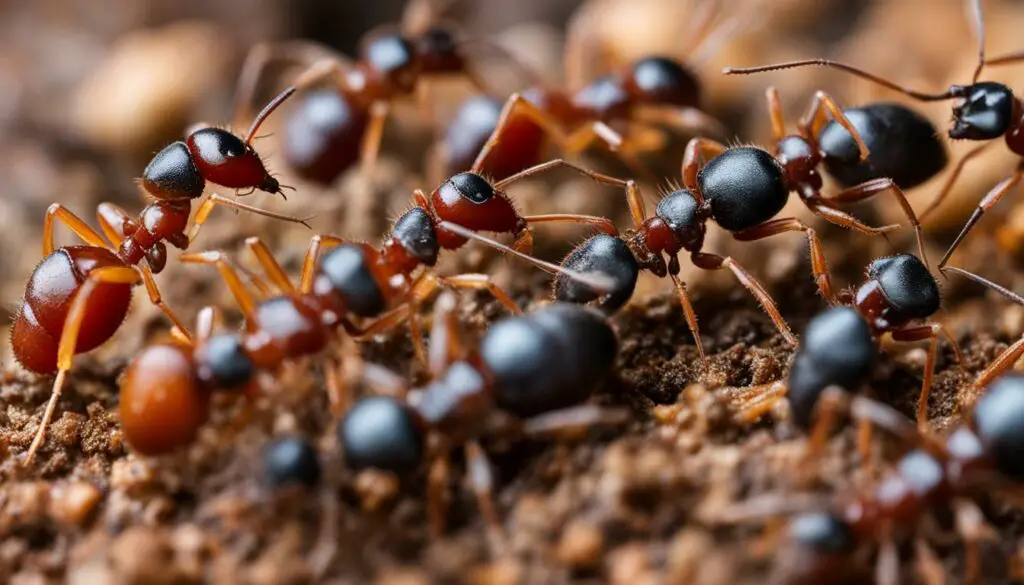
In the next section, we will explore the role of male ants in the colony and their contributions to the overall functioning. Stay tuned!
The Role of Male Ants
Male ants, also known as drones, play a crucial role in the lifecycle of an ant colony. Their primary task is to mate with the queen ants, ensuring the survival and continuation of the colony. Unlike female ants, males have a shorter lifespan and do not contribute to the day-to-day tasks of the colony.
Male ants are equipped with wings, allowing them to fly and search for potential mates. Once they find a receptive queen, they engage in a mating ritual, after which they die. This mating process ensures genetic diversity within the colony and helps establish new colonies in different locations.
While male ants may not have the same responsibilities as their female counterparts, their contribution to the overall success of the colony should not be underestimated. By fulfilling their role as mates, male ants ensure the continuation of their species and the survival of their colony.
It is important to note that not all ant colonies have males. Some species of ants reproduce through a process called parthenogenesis, where females can produce offspring without mating. This adaptation allows colonies to thrive even in the absence of male ants.
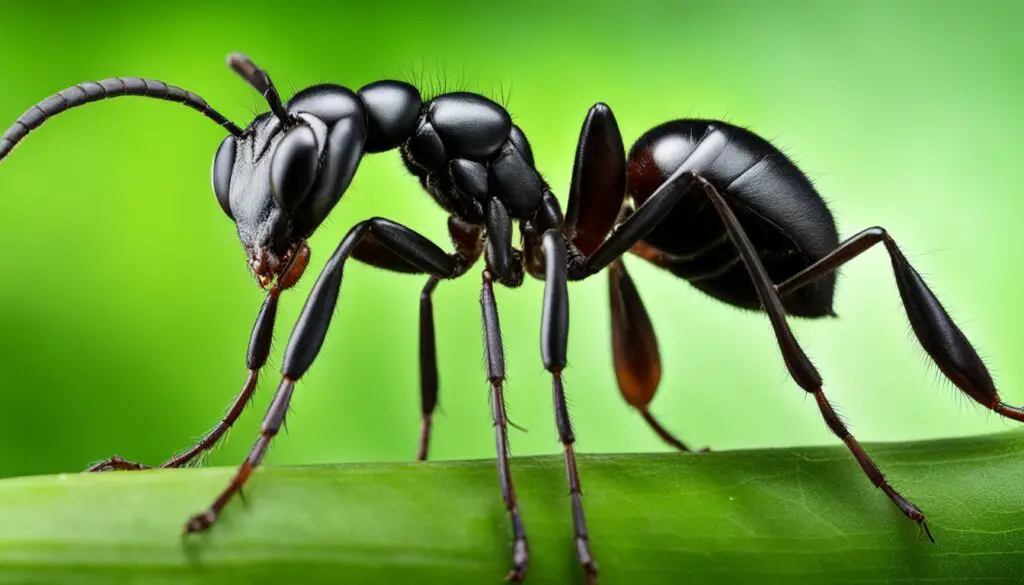
Key Points:
- Male ants have a specific role in the reproduction and continuation of the ant colony.
- They mate with queen ants to ensure genetic diversity and the establishment of new colonies.
- Male ants have a short lifespan and do not contribute to the day-to-day tasks of the colony.
- Some ant species reproduce through parthenogenesis, eliminating the need for male ants in the colony.
| Role | Lifespan | Tasks |
|---|---|---|
| Male Ants | Short lifespan | Mating with queen ants |
Lifespan Variations in Ants
When it comes to the lifespan of ants, there are several factors that can influence how long these fascinating creatures live. The average lifespan of an ant varies depending on the species, the role in the colony, and the availability of food. While some ants may only live for a few weeks, others can live up to an impressive 15 years.
The queen ant, being the largest ant in the colony, tends to have a longer lifespan compared to other castes. Queens can live for several years, and under the right conditions, they can even live for decades. This extended lifespan is crucial as queens are responsible for laying all the eggs in a colony and ensuring the colony’s survival.
Worker ants, on the other hand, have a shorter lifespan compared to queens. They typically live for several months, during which they perform various tasks such as taking care of the brood, building and cleaning the nest, and foraging for food. Their hard work and dedication contribute to the overall functioning of the colony.
Male ants, also known as drones, have the shortest lifespan of all castes. Their sole purpose is to mate with queens, after which they usually die. They do not contribute to the tasks of the colony and have a relatively short existence.
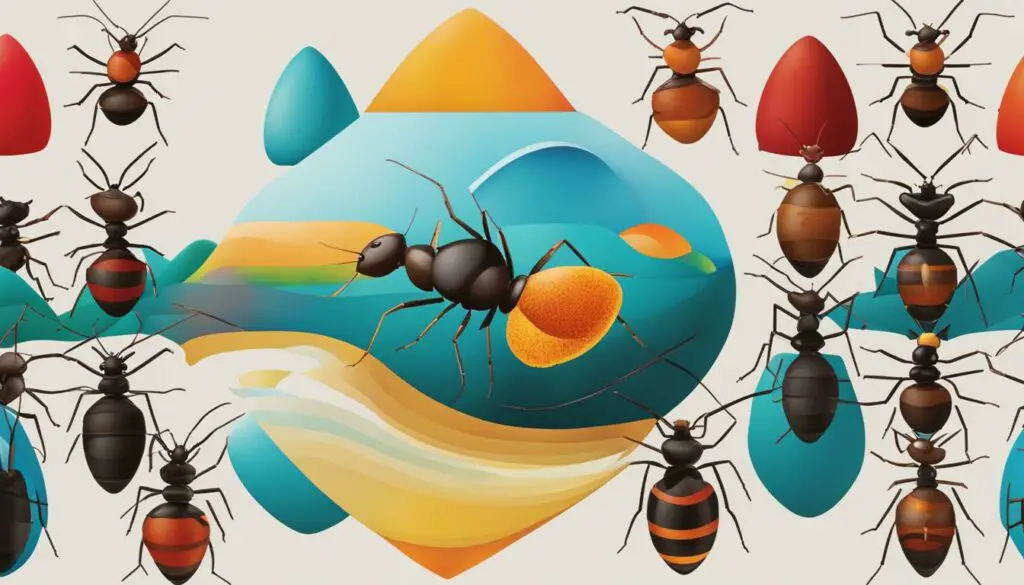
Ant Lifecycles in Nature
Ant lifecycles are a fascinating aspect of nature that showcases the intricate growth and development of these tiny creatures. Understanding the stages of ant colony life is essential for studying their behavior and the growth of their colonies. From the egg stage to adulthood, ants go through a series of transformative phases.
During the egg stage, ant eggs are soft, oval, and tiny. Not all eggs develop into adults as some may be consumed by other nestmates. The size of ant eggs can be compared to the size of a period at the end of a sentence. Once hatched, the larvae stage begins. Larvae are worm-shaped and rely on adult ants to provide them with food. They grow rapidly by molting between sizes and are voracious eaters during this stage.
After the larva stage, ants enter the pupa stage, a phase of rest and reorganization. Pupae have folded legs and antennae and start out whitish before gradually darkening. Some species spin a cocoon, while others remain uncovered. Finally, the pupae emerge as fully formed adult ants. These young adults may be lighter in color and darken as they age. The process of development from egg to adult can take several weeks to months.
| Ant Colony Life Stages | Description |
|---|---|
| Egg Stage | Ant eggs are soft, oval, and tiny. Not all eggs develop into adults as some may be consumed by other nestmates. |
| Larva Stage | Larvae are worm-shaped and rely on adult ants for food. They grow rapidly by molting between sizes. |
| Pupa Stage | Pupae have folded legs and antennae. They start out whitish and gradually darken. |
| Adult Stage | Adult ants emerge from pupae as fully formed individuals. They may lighten or darken in color as they age. |
The lifecycles of ants in nature are a testament to their resilience and adaptability. By understanding these lifecycles, researchers and enthusiasts gain valuable insights into ant behavior and the dynamics of their colonies. The intricate roles played by different castes, such as the queen, workers, and males, contribute to the overall growth and success of ant colonies.
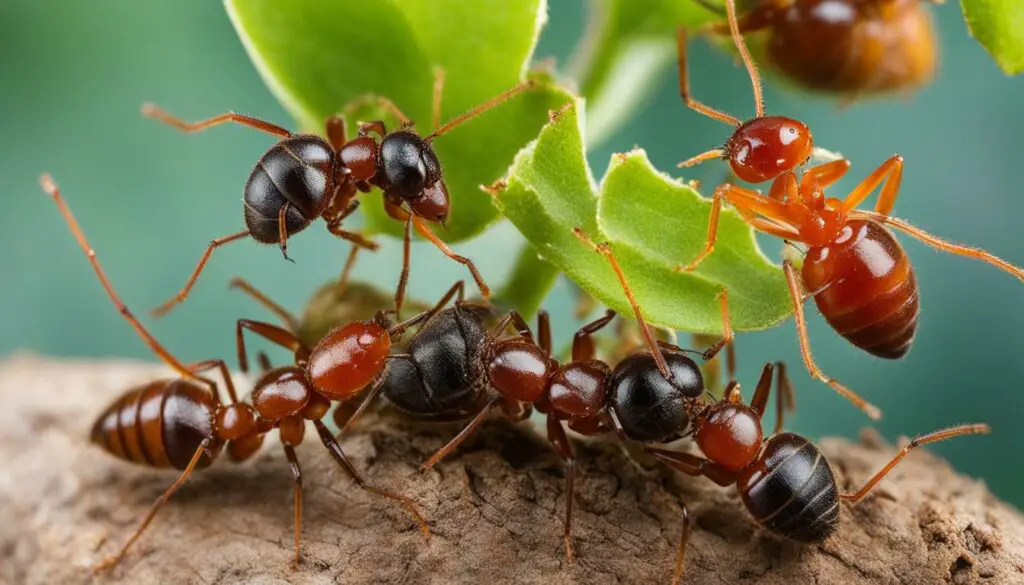
The Importance of Ants in Ecosystems
Ants play a crucial role in maintaining the balance of ecosystems. These tiny creatures have a significant impact on the environment, contributing to various ecological processes. Their diverse activities help to support the health and sustainability of ecosystems.
One of the key roles of ants is seed dispersal. As ants scavenge for food, they often come across seeds. They pick up these seeds and carry them back to their nests. In the process, some seeds get dropped and left behind, which helps to distribute and scatter seeds across different areas. This seed dispersal activity by ants is vital for the regeneration and growth of plant species in ecosystems.
Ants also contribute to soil aeration, which is essential for the health of plants. As ants dig tunnels and create underground colonies, they loosen the soil, allowing air to penetrate and improving soil structure. This enhances nutrient availability and water infiltration, benefiting plant growth. Additionally, the tunnels created by ants provide pathways for water and roots, aiding in the overall health and resilience of ecosystems.
In addition to seed dispersal and soil aeration, ants play a crucial role in pest control. Many ant species are predators and feed on small insects, reducing their populations. This helps to regulate the number of pests in an ecosystem, preventing outbreaks that can harm plants and other animals. Ants also act as scavengers, cleaning up dead organic matter and recycling nutrients back into the soil, contributing to the overall nutrient cycling in ecosystems.
| Role | Impact |
|---|---|
| Seed dispersal | Contributes to the regeneration and growth of plant species |
| Soil aeration | Improves soil structure, nutrient availability, and water infiltration |
| Pest control | Regulates pest populations, preventing outbreaks |
| Nutrient recycling | Cleans up dead organic matter and recycles nutrients back into the soil |
Overall, ants have a significant ecological significance. Their activities contribute to the overall health and balance of ecosystems. By understanding and appreciating the role of ants, we can better appreciate the intricate web of life and the interconnectedness of all living organisms in the natural world.
Fun Facts About Ants
Ants are fascinating creatures that have captured the curiosity of both children and adults alike. Here are some fun facts about ants that will amaze you:
A Diverse Family
Did you know that there are over 12,000 species of ants worldwide? These tiny insects come in a variety of colors, shapes, and sizes. From the iconic black ants to the vibrant red fire ants, ants display incredible diversity in their appearance.
Super Strength
Ants are known for their remarkable strength. Despite their small size, ants can carry objects that are many times heavier than their own body weight. In fact, it is estimated that some ants can carry up to 50 times their own weight. This incredible strength is due to their unique body structure and strong mandibles.
Highly Organized Societies
Ants live in complex societies with specialized roles and divisions of labor. They work together to build intricate nests, gather food, and care for their young. Ant colonies operate like well-oiled machines, with each ant playing a crucial role in the overall functioning of the colony. This high level of organization is one of the reasons why ants are so successful as a species.
| Fun Fact | Ant Fact |
|---|---|
| Ant Species | Over 12,000 species of ants exist worldwide |
| Strength | Ants can carry objects up to 50 times their own weight |
| Social Structure | Ant colonies have highly organized societies with specialized roles |
These are just a few of the many fascinating facts about ants. Their strength, diversity, and social structure make them truly remarkable creatures. The next time you come across an ant, take a moment to appreciate the incredible world that they inhabit.
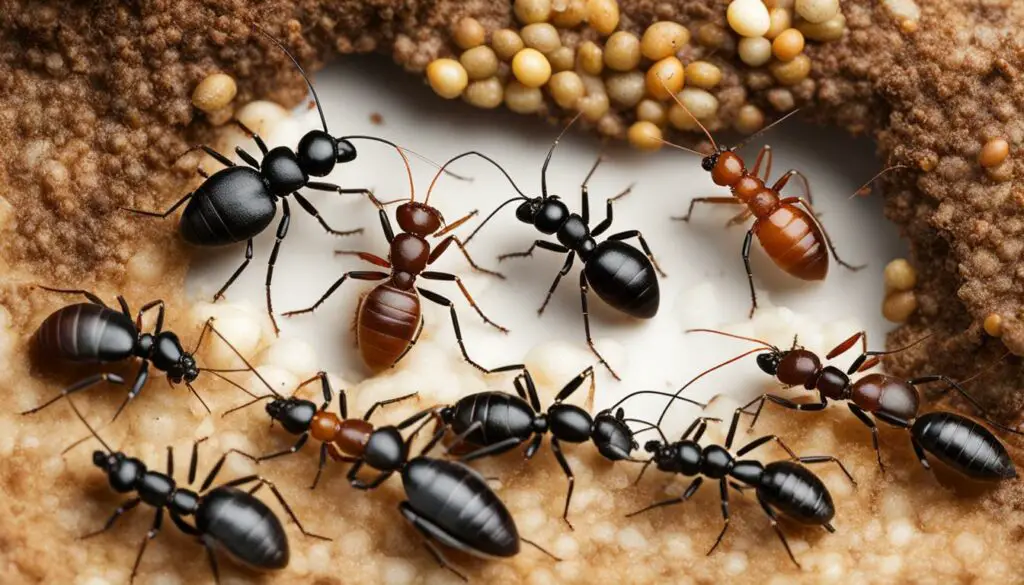
Printable Resource for Learning Ant Lifecycles
If you’re looking for a fun and educational activity to teach children about ant lifecycles, we have the perfect printable resource for you. Our ant lifecycle resource includes 3-part cards and a sorting mat that will engage children in sequencing the stages of an ant’s life. This interactive activity will help children understand the different stages of an ant’s life, from egg to adult.
The 3-part cards are designed to be visually appealing and informative. Each card features an image of a specific stage of the ant lifecycle, along with a label. Children can match the image with the corresponding label to reinforce their understanding of the different stages. The sorting mat provides a hands-on experience for children to arrange the cards in the correct order, allowing them to visualize the progression of the ant’s life cycle.
This printable resource is not only educational but also entertaining. It encourages children to actively participate in the learning process, fostering their curiosity and love for nature. By engaging with the ant lifecycle activity, children will gain a deeper appreciation for the fascinating world of ants and their incredible life cycles.
| Features of the Printable Resource: |
|---|
| 3-part cards with images and labels |
| Sorting mat for sequencing the stages |
| Engaging and interactive activity |
| Promotes curiosity and love for nature |
Introduce your child to the fascinating world of ants with our printable resource. Download it now and embark on an exciting journey to explore the lifecycle of these incredible creatures!
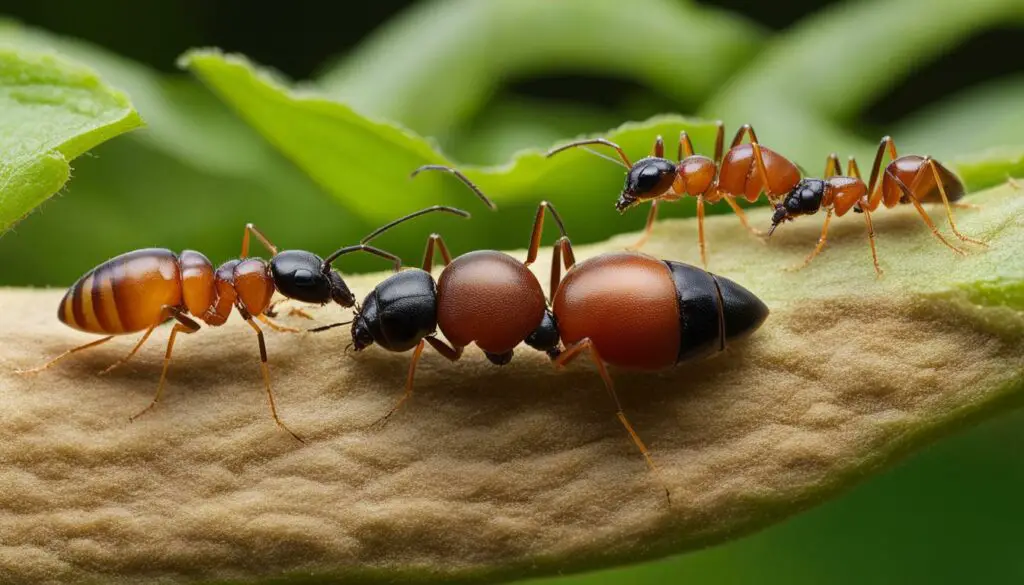
Conclusion
Ant lifecycles and stages offer us a fascinating glimpse into the hidden world of these remarkable creatures. From the tiny, oval-shaped ant eggs to the fully grown adults belonging to different castes, each stage plays a vital role in the survival and growth of ant colonies.
Through complete metamorphosis, ants progress from eggs to larvae, then pupae, before emerging as adults. This journey is marked by continuous growth, molting, and the development of unique characteristics. The queens, workers, and males each fulfill specific roles within the colony, contributing to the efficient functioning of their societies.
Ant lifecycles have a significant impact on ecosystems. These industrious insects aid in seed dispersal, maintain soil health through their tunneling activities, and even serve as natural pest controllers. Their social structures and specialized tasks foster a balanced and harmonious environment.
By understanding ant lifecycles and stages, we gain a deeper appreciation for the intricacies of these tiny creatures and their contributions to the natural world. From their remarkable ability to communicate through scent to their impressive strength, ants never cease to amaze. So let’s continue to marvel at the wonders of ant lifecycles and celebrate the essential role they play in our ecosystems.
FAQ
What are the different stages of an ant’s life cycle?
Ants undergo four stages: egg, larva, pupa, and adult.
What do ant eggs look like?
Ant eggs are soft, oval, and tiny, similar in size to a period at the end of a sentence.
How do ant larvae grow?
Ant larvae rely on adults for food and grow rapidly by molting between sizes.
What happens during the pupa stage?
Pupae are a stage of rest and reorganization, where the ant undergoes metamorphosis and gradually becomes darker.
What are the different castes of adult ants?
Adult ants belong to one of three castes: queen, worker, or male.
What is the role of ant queens?
Ant queens lay all the eggs in a colony and can live for decades.
What tasks do ant workers perform?
Ant workers take care of the brood, build and clean the nest, and gather food.
What is the purpose of male ants?
Male ants mate with queens but do not help with colony tasks.
How long do ants live?
The lifespan of an ant varies depending on the species and role in the colony. Some ants live for a few weeks, while others can live up to 15 years.
What is the importance of ants in ecosystems?
Ants aid in seed dispersal, soil aeration, and pest control, contributing to the balance and health of ecosystems.
Are there any interesting facts about ants?
Yes, ants have a strong sense of smell, can lift objects heavier than their own body weight, and live in specialized roles within their society.

